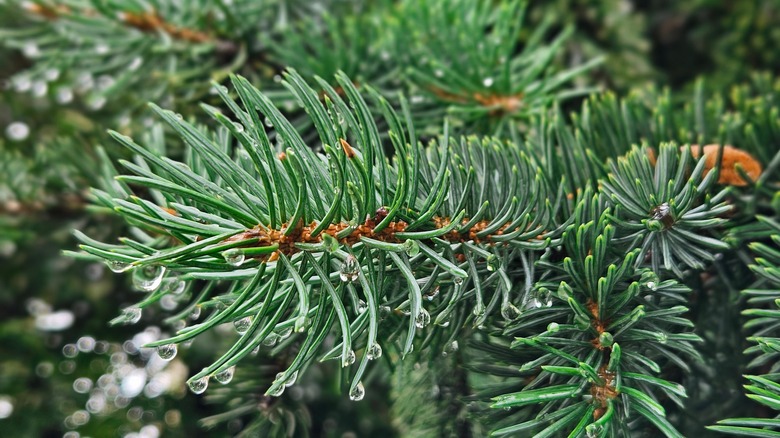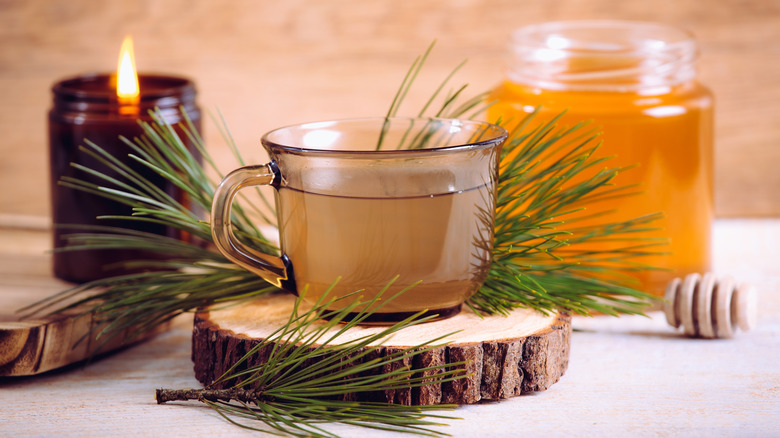Can You Eat Your Christmas Tree?
"Can I eat my Christmas tree?" is a question that you probably never thought to ask. The needles don't look like something you'd want to add to your winter green salad, but they do have a lovely aroma. If you love that pine-fresh scent and are a fan of botanical and herbaceous flavors, you can, in fact, consume many of the most popular varieties of Christmas trees, such as pine, fir, and spruce trees.
It may be unconventional, but using the fragrant leaves (or in this case, needles) of trees in cooking is hardly an untapped concept. Lots of plants are prized for their strong aromas, including lavender, sage, jasmine, and rose. Many of these species — though not all — have both edible fruits and leaves. Many cultures around the world enjoy eating the leaves of limes, grapes, and mulberries. Pine nuts even come from pine cones, which of course, come from specific species of pine trees. Think of the needles on your Christmas tree as a sort of extra-hardy rosemary that lends an irreplaceable aroma to your recipes.
However, as you might imagine, consuming parts of your tree is not a super straightforward practice. Cedar, cypress, and yew Christmas trees are poisonous, while commercially-produced trees are often treated with pesticides you wouldn't want to eat. While these chemicals are also commonly used on other food products, if you're going to eat something that's not really treated as food, seeking out an organic, pesticide-free tree is the safest option.
How to prepare your Christmas tree for cooking
After you've made sure that your tree is okay to use in cooking, start by snipping off a branch or two. You then need to wash the needles thoroughly under cool running water to clean off any dirt or dust, as well as anything left behind by your Christmas decorations. After that, use a pair of kitchen scissors to snip the needles off of the branches into a large bowl of water, and give them another good swish. Drain them through a fine mesh strainer, and finally, allow the needles to dry on a clean kitchen towel, or speed up the process with a salad spinner.
As mentioned previously, pine, fir, and spruce needles are all edible, but they each have a different taste. Julia Georgallis, author of the recipe book "How to Eat Your Christmas Tree," says that spruce needles have notes of orange and vanilla, and fir needles are "zesty and really grassy." She adds that "Pine doesn't taste like it smells. It's very delicate and almost floral" (per Smithsonian Magazine). Georgallis especially loves the taste of blue spruce. All tree needles can be quite sharp, so definitely wear protective gloves when handling them.
How to cook your Christmas tree
For your holiday drinks and meals, there's nothing like the very essence of a Christmas tree distilled into your cooking. You can allow the clean needles to steep in vinegar, in honey, or in hot water to make tea. You can also steep them in alcohol — gin would work especially well. The resulting flavored liquids can act as a base for drinks and condiments. Use the infused honey to make a vinaigrette or marinade, the vinegar to make pickles, and the liquor to make mini Christmas tree cocktails. Tree-based tea can also be cooked down with sugar to make syrup perfect for beverages or desserts.
If your Christmas tree needles are on the softer side, you can chop them very finely and then combine with either sugar or salt. Use Christmas tree salt for roasting meats, curing fish, or adorning a loaf of homemade bread, and use the sugar to add an aromatic crunch to baked goods, or to rim a glass of holiday punch.
You can also keep the branches whole and use them for smoking or barbecuing. Mix the branches in with your usual grill pellets or logs, or place them directly on the coals of your grill. They'll add an amazing aroma to your food and the area where you're cooking. Alternatively, use the branches to create a bed for oven-roasted chicken, rack of lamb, or thick slices of winter squash. Whether you live a low-waste lifestyle, or you're just trying to incorporate Christmas cheer into your food in as many ways as possible, you should definitely give Christmas tree cooking a try.



